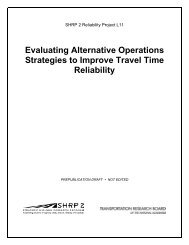Annotated Bibliography - SSTI
Annotated Bibliography - SSTI
Annotated Bibliography - SSTI
Create successful ePaper yourself
Turn your PDF publications into a flip-book with our unique Google optimized e-Paper software.
Title Evaluating Public Transit Benefits and Costs: Best Practices Guidebook<br />
Authors Todd Litman<br />
Sponsor Victoria Transport Policy Institute (VTPI)<br />
Date October, 2011<br />
Pages 124<br />
Category BCA, Modes: Transit<br />
Note<br />
Online http://www.vtpi.org/tranben.pdf<br />
Summary The report serves as a "comprehensive framework" for comparing costs and benefits of<br />
automobile transportation to public transit, including productivity gains and property<br />
values. It distinguishes between efficiency‐justified and equity justified services and the<br />
measures used when considering transit and automobile use. Efficiency‐justified<br />
services that intend to decrease congestion, accidents, and pollution, can be analyzed<br />
using indicators that concentrate on cost‐effectiveness such as costs per passenger‐mile<br />
or benefit‐cost ratio. Equity‐justified services aim to provide transport to disadvantaged<br />
individuals.<br />
The report also provides a comprehensive cost comparison summary between transit<br />
and automobile investment including "urban‐peak external costs of transit and<br />
automobile" and "per capita annual external costs of transit and automobile users".<br />
Among the 12 costs calculated are operating subsidy, right of way land value,<br />
congestion, external parking, and congestion. The average external costs per passenger<br />
mile are assessed as $.202 for a car with an auto occupancy of 1.42 and $.336 for a<br />
diesel bus with 10.2 passengers. However, under urban peak conditions externalities<br />
are greater for auto travel and transit is its most efficient due largely to higher<br />
passenger loads, almost reversing the relationship ($.464 for auto and $.295 for transit<br />
ppm. The author urges individual analysis for each project and consideration of the<br />
equity aspects of transit subsidy.<br />
<strong>Annotated</strong> <strong>Bibliography</strong> Page 22















